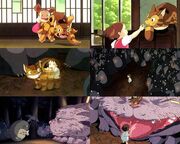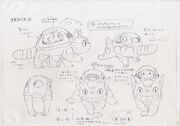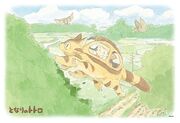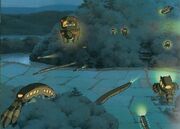Mei and the Kittenbus (original) (raw)
Mei and the Kittenbus (めいとこねこバス , Mei to Konekobasu) is a 13-minute animated film written and directed by Hayao Miyazaki and produced by Studio Ghibli and premiered in October 2002. It is the sequel to the 1988 film My Neighbor Totoro and is one of the twelve short films shown exclusively at the Saturn Theater, located at the basement of the Ghibli Museum in Mitaka, Tokyo and Cinema Orion in Ghibli Park. It has been considered the museum's most popular short film.
The film tells the lighthearted story of Mei and her adventures with the Kittenbus, a child version of the Catbus. Totoro also makes a return appearance. As the sequel to a beloved classic, Miyazaki stated, “This piece was made specially for children.” This was possibly the last film of Hitoshi Takagi, the voice of Totoro, before his death and is the only direct sequel made to any Ghibli film. Joe Hisaishi returned to score the project.
In 2003, the film was screened for John Lasseter and his staff during Miyazaki's visit to Pixar in California, as seen in the DVD special, Lasseter-San, Arigato!.
Plot[]
Various stills from the film, including Mei offering the Kittenbus a piece of caramel to her entering the spirit realm to meet the Granny Cat and fellow Totoro-like gods.
All is well at Mei's home. Two months have passed after her mother returned home from the hospital. Mei goes outside to a little stone hill and watches the skies. When she eats a Japanese caramel cube candy, a mini whirlwind suddenly comes spinning her dress. The whirlwind chases after Mei and she runs back into the house where she manages to trap the whirlwind. It turns out to be a Kittenbus. The Kittenbus is scared and tries to escape the room at first, but bonds with Mei after she gives him a caramel cube to eat with her. The Catbus shows up, and Mei opens a window to let the Kittenbus follow the catbus into the air.
Later that night, the Kittenbus takes Mei for a ride. Along the way, they spot the catbus, the kittenbus' father, which is filled with spirits like Totoro. Another catbus pulls up beside them, and soon a variety of cat vehicles appear, such as a cat-train, all filled with Totoro-like spirits. The Catbuses drop their passengers off, and the Kittenbus drops Mei off with them. The spirits move apart to reveal Totoro, who is very happy to see her.
Mei hops onto his chest and he takes her to a giant, ancient Granny Cat that is being boarded by the spirits. The Kittenbus appears on his head and Mei asks the Kittenbus, "Is this your grandma?" in which the Kittenbus meows back. Mei introduces herself as the Kittenbus' friend, and proceeds to feed her a caramel cube. A few minutes are taken to eat the caramel candy where she almost chokes, but is ultimately happy after swallowing. She gives Mei a lick and she licks her back. The giant cat liner leaves while Totoro stays behind. Mei and the Kittenbus follow them for a while, then return to Mei's house.
Characters[]
Mei Kusakabe (草壁 メイ, Kusakabe Mei)
Main protagonist of this short. Mei is the younger sister of Satsuki. She's bright, energetic and loves eating sweets. She enjoys playing around with the Kittenbus, along with Totoro and his companions.
Totoro (トトロ(大トトロ), Totoro)
The enigmatic Totoro is a spirit that helps guide Mei and the Catbus to meet the wizened old Granny Cat.
Catbus (ネコバス , Neko Basu)
The Catbus is a flying anthropomorphic cat bus.
Kittenbus (こねこバス , Koneko Basu)
The Kittenbus is the smaller, more compact version of the Catbus.
Granny Cat (ネコばあちゃん, Neko Bāchan)
The Granny Cat is the largest and oldest of the catbuses in the film. Able to fit hundreds of forest spirits, she is similar in build to a cruise liner. Mei refers to the Granny Cat as akin to a grandmother.
Satsuki Kusakabe (Cameo) (草壁サツキ , Kusakabe Satsuki)
Mei's older preteen sister. She is seen very briefly, sleeping next to Mei.
Production[]
Character sheet for the Kittenbus with Mei inside it.
In 1999, following the release of Isao Takahata's My Neighbors the Yamadas, rumors circulated that Hayao Miyazaki was considering making a sequel to My Neighbor Totoro.[1]
Following the success of Spirited Away and the opening of the Ghibli Museum in 2001, Hayao Miyazaki began storyboard work for this film. The story would be set two months following the events of My Neighbor Totoro and star Mei. Miyazaki teased the appearance of the Kittenbus prior to its release.[2] Like Spirited Away, the film shares themes of characters visiting a realm of gods and spirits, notably an area populated by Totoro-like spirits. The film also introduces "Neko Bāchan", the Granny Cat who was described as a "grandma", who was voiced by Miyazaki.
A sketch of Mei in the Kittenbus by Hayao Miyazaki.
A total of about 15,000 animation drawings were necessary to complete the entire 13-minutes short. Chika Sakamoto, who was aged 50 at the time, reprised her role as Mei some fourteen years after the original. She jokingly said, "I've grown up since then." Hitoshi Takagi, the original voice of Totoro, also reprised his role one last time. According to Noriko Hidaka, the actress who played Satsuki, "The voice of Catbus and the voice of the spirit who helps Satsuki and Mei in the beginning are the same voice actor." It is the third animated short film made exclusively for the museum, following The Whale Hunt and Koro's Big Day Out.
Music[]
Joe Hisaishi introduced a new theme in pivotal scene involving several cat buses entering the forest.
The soundtrack, Mei and the Kittenbus (めいとこねこバス サウンドトラック , Mei to Konekobasu Saundotorakku) was released under the Museo d'Arte Ghibli label and sold exclusively at the Mamma Aiuto shop in the Ghibli Museum on October 2, 2002. Joe Hisaishi completed the soundtrack in August 2002, which notably reprises many themes from the original My Neighbor Totoro. Two of the eight songs are new melodies, with the first being the scene where Mei offers the Kittenbus a piece of caramel candy. "I made this song with the feeling of Mei's character... 'Ta-ra-ri-ra-ra'... that is Mei's theme." While the melody sounded simple, it was actually composed of a complicated rhythm.
"I wanted to add some complexity to the simple melody, but make it interesting and easy to hum," says Hisaishi, who was very happy with the result. When the song was completed, he was convinced that it would be the core of the film's score and a key theme of joy for Mei and Kittenbus".[3]
The other new theme composed by Hisaishi is the scene involving several cat buses entering the forest. "That scene is a big turning point in the story. I wanted to make it a little more interesting and impressive." So Hisaishi introduced an oboe-type musical instrument called the "Crumhorn", which has an interesting shape like the handle of an umbrella. "It's interesting because it has an ethnic feel." In this way, new songs have been added to the song My Neighbor Totoro, and the music that plays alongside the video makes the work even more enjoyable.[4] Kei Yasui and Yuko Shoji played the Crumhorn, while New Japan Philharmonic Orchestra performed the soundtrack.[5]
Trivia[]
- This is the only sequel that Studio Ghibli has ever produced.
- In 2017, an informal poll by a fan revealed that few knew of the existence this film and its identity as a sequel to My Neighbor Totoro. Roughly 88 percent of the more than 102,000 respondents said they had never heard of the film.[6] This is mostly due to how the film were exclusively screened only at the Ghibli Museum in Mitaka.
- In 2003, the film was screened for John Lasseter and his staff during Hayao Miyazaki's visit to Pixar in California, as seen in the DVD special, Lasseter-San, Arigato!. Lasseter, Miyazaki and Toshio Suzuki then traveled to Lasseter's home in Sonoma where his family described how they were huge fans of Totoro. Miyazaki proudly admitted he was the voice of the Granny Cat in the film.
Voice Cast[]
While the main cast has been identified, many of the other roles and background voices are uncredited.
| Character | Voice Actor (Japanese) |
|---|---|
| Mei | Chika Sakamoto |
| Kittenbus | Hayao Miyazaki |
| Totoro | Hitoshi Takagi |
Credits[]
| Credit | Staff |
|---|---|
| Director, Screenplay | Hayao Miyazaki |
| Animation Director | Makiko Futaki, Sachiko Sugino, Hiromasa Yonebayashi |
| Key Animation | Megumi Kagawa, Kenichi Yamada, Masaru Matsuse, Misuzu Kurata, Kazuyoshi Onoda, Makiko Suzuki, Tamami Yamada, Atsushi Tamura, Kaori Fujii, Yoshinori Noguchi, Kojiro Tsuruoka, Hiroomi Morita, Nobuyuki Takeuchi, Masaru Oshiro |
| In-between Animation | Tadashi Yazawa, Aya Bridge, Yokota real, Nozomu Ito, Onishi Mayu, Mariko Suzuki, Rie Nakagomi, Akiko Teshima, Masako Sato, Uminai Tsutomu, Shuko Sasakawa, Katano Yoshi, Sakurako Yamada, Fumie Konno, Shinichiro Shunsuke, Yayoi Toki, Masako Banno, Mayumi Omura, Yumiko Makita, Sumie AzumaSeiko, Yukari YAMAURA, Shiina Ritsuko, Iwayanagi Rie, Hayashi Kondo, Rie Hiromi, Nishikawa, Fujimura Emiko, Kumiko Terada, Naoko Fujitani, Yamada Nobushige, foster child Kaori Ito, Kunitoshi Ishii, Kano Masashi, Yamada, Masayuki, Shimizu Saho, Saito Masahiro, Shinoda Daisuke, Makino Tetsuaki, Takuya Kawai, Matsumoto Ayako Noda, KoYoshi Nakano, Yoko Shikibe, Miyoko Hamada Takayuki |
| Background Artists | Naoya Tanaka, Naomi Kasugai, Tomoe Ishihara, Osamu Masuyama, Hiroaki Sasaki |
| Digital Painting | Kanako Moriya, Naomi Mori, Fumiko Oda, Hiroaki Ishii, Kazuko Yamada, Yukie Nomura, Akihiro Oyama, Rie Okada, Kiyoko Saito |
| Color Design | Michiyo Yasuda |
| Art Director | Ryoko Ina |
| Animation Cooperation | Studio Takuranke, Anime Toro Toro, Video Studio Telecom, Animation Film, Yumegenkan |
| Producer | Toshio Suzuki |
| Music | Joe Hisaishi |
| Editor | Takeshi Seyama |
Gallery[]
References[]
- ↑ Blog entry regarding rumors of "My Neighbor Totoro" sequel in the works since 1999.
- ↑ Blog entry regarding Miyazaki teasing Kittenbus appearance.
- ↑ Joe Hisaishi fansite featuring an interview with Hisaishi on composing "Mei and Kittenbus".
- ↑ From the official pamphlet of "Mei and the Kitten Bus"
- ↑ Discogs profile on "Mei and Kittenbus".
- ↑ RocketNews24 on people learning about "Totoro" sequel.
External Links[]
 Mei and the Kittenbus on Anime News Network
Mei and the Kittenbus on Anime News Network Mei and the Kittenbus at the Internet Movie Database
Mei and the Kittenbus at the Internet Movie Database- Mei and the Kittenbus on Wikipedia



